How to Deliver Effective Online Tutoring as a Science Tutor
By Dr Scott R. Dempsey on 25th October, 2021

This article is part of a series on how to deliver effective online tutoring across a variety of subjects.
Previously, we have reported the tips and strategies that top tutors use to deliver effective maths lessons and English lessons online. We’ve also published articles on tutoring younger students online and tips from students on what they consider to be essential components of online tutoring.
Today, I’m going to share my experience as a science tutor with almost 1,000 hours of online tutoring experience behind me.
In addition to my tips, we’ll be featuring some of the most insightful feedback we’ve received from other top science tutors on what makes for effective, engaging and ultimately productive online tutoring lessons.

My session library. Highlighting taught sessions on Bramble since June 2019.
This article is broken down into 6 key areas:
- Your tutoring setup
- Getting the most out of the platform tools
- Collecting and sharing resources
- Using different approaches
- Tracking student progress
- Insights from 1.5 million hours
Let’s start with the setup...
1. Ensure that you AND your student are set up correctly
Football players need football boots, pianists need a piano. As an online tutor there are certain tools you need to be effective and to enjoy your online experience. Some of these tools are necessary whilst others enhance your experience to varying degrees.
The necessary equipment is as follows:
- A device to tutor on
- Headphones
- A good internet connection
If you’ve done any tutoring online before, these should be fairly self explanatory. However, a couple of additional accessories go a long way when it comes to tutoring science subjects.
The first is a device to draw with.
This makes a significant difference when it comes to drawing and labelling diagrams. If you have access to a touchscreen device such as a touchscreen laptop or tablet, this would be a preferred option as it offers all of the flexibility of working with pen and paper. You can read more about some of the options we recommend here.
The second, and more affordable option, is to use a drawing tablet.
Drawing tablets are a fraction of the cost of touchscreen devices but will significantly improve your online science tuition by enhancing your ability to draw on your online whiteboard.
If you want to get creative, you might think about adding in a camera to perform experiments and practical demonstrations online...
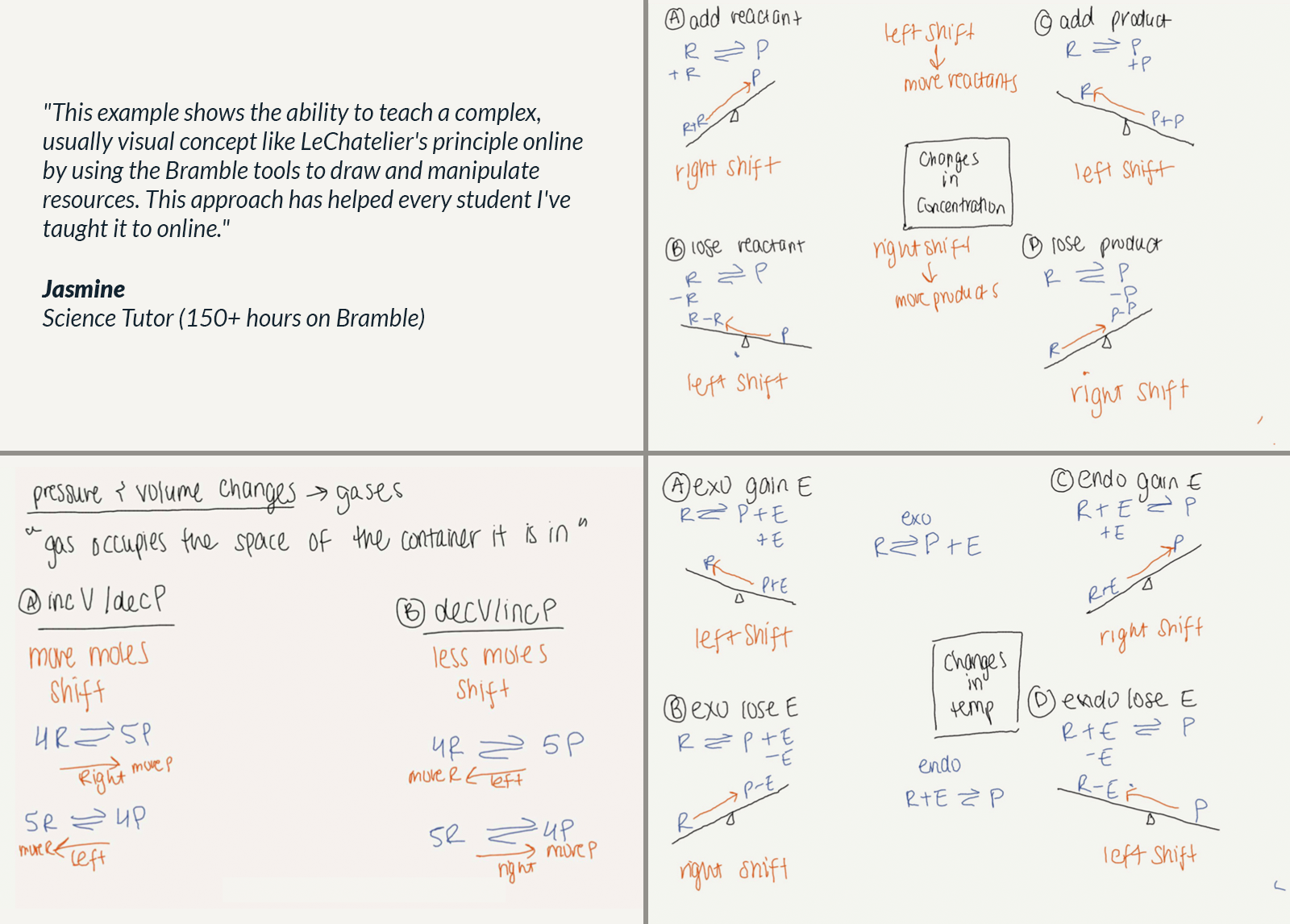
Example of an online chemistry lesson from tutor, Jasmine.
“One thing I have found really helpful is to get a drawing tablet. I got mine off Amazon for £30 and it has been really handy for improving my handwriting on the board. I also have a camera set up on the desk which means that students can watch me perform constructions or use manipulatives or even carry out experiments, logging results in real time. They really seem to like this.”
Maddie - Maths, Chemistry and Physics Tutor (400+ hours on Bramble)
Personally, I like to operate with a second screen. Whilst this can be a personal choice and dependent on what you have available, I find that using a touchscreen to work on and a second screen for your resources or online textbooks works really well. It also makes screenshotting resources you wish to import into Bramble a lot quicker and easier.
Finally, it’s important to ensure that your students are also set up correctly. I have noticed that those who are comfortable drawing and annotating on the screen tend to be more involved and engaged in the lesson.
Which brings us to the next point...
2. Getting the most out of the platform tools
Taking the time to ensure that your students are comfortable using the platform tools is important. It’s more beneficial for the student if they are the ones labelling the components of a cell and writing the answers to questions on Newton’s laws, rather than you.
Allowing your students to take control of their online learning means them being comfortable with drawing, writing and uploading documents (such as homework). In fact, many of my students upload their science homework or problems they’ve been working on prior to the lesson so it’s ready to work on as soon as the session starts.
Here are some real examples of how science tutors use the platform tools for engaging online sessions.
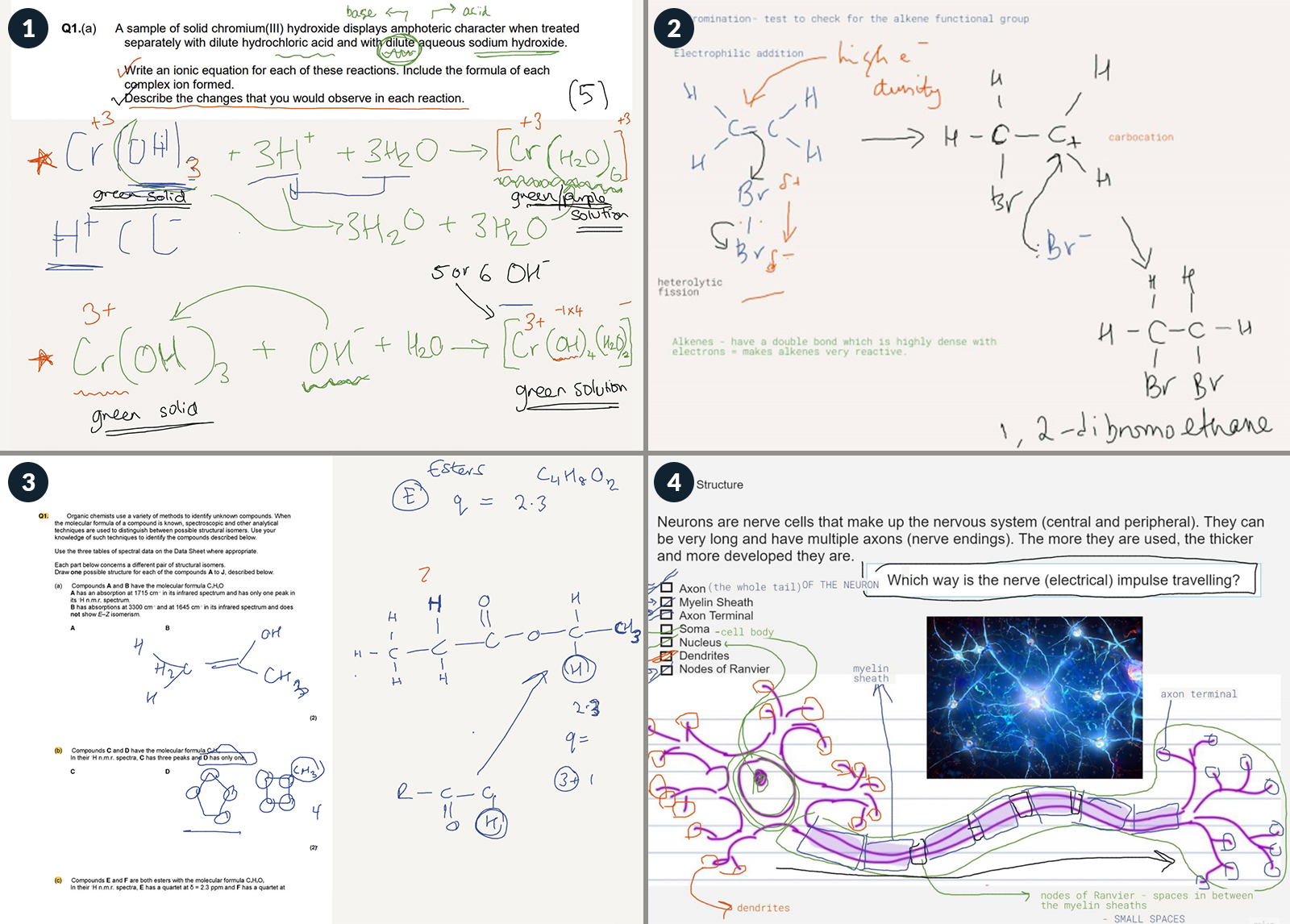
Multiple page examples from online science tutors. See below for descriptions.
(1) "My screenshot shows how useful Bramble is for working through exam questions in real-time with a student. This screenshot is of an exam-question I was working through with an A Level Chemistry student. I could easily copy the exam question onto our shared whiteboard and then we can talk through the theory together. The multiple colours make it easy for both of us to write on the page and to follow each other's thought processes, especially if we want to explain something further. When we've finished we can easily move on to the next page and start again with another question whilst the previous page is saved for us to use/review later!"
Alyssa Fox-Charles, Chemistry Tutor (150+ hours on Bramble)
(2) "Bramble helps to draw excellent diagrams. This example shows electron flow diagrams in chemistry. The student works on parts of it while I can assess their understanding."
Rubeena, Chemistry Tutor (50+ hours on Bramble)
(3) "I chose this example because it encompasses many of the great features of Bramble. For example, you can see that I was able to upload a question paper for both myself and the student to upload. The student could then use the RHS to annotate and draw his ideas for an answer and I could provide instant feedback to his train of thought and how he arrived at those answers and guide him towards the right answer in the end."
Ryhan Miah, Science Tutor
(4) "This is an image of a neuron. I like to prepare my slides beforehand and still have the interactive aspect so that my students can feel like they're allowed to ask questions and interact with the content. When I have a diagram, I won't label it directly, but provide the names and structures, which I can then use to explain the diagram step by step. The students can also guess and mark different areas of the structure that they want to remember or label the function of."
Kim Li-Lakkappa, Biology Tutor (100+ hours on Bramble)
Here are some additional thoughts on getting the most out of the platform...
“Take the time to check your set-up beforehand so you're familiar with your class plan as well as what technology you'll need to pull it off. Allow your students to interact with your slides and your content as much as you can - they should feel like a part of the class, instead of listening to a lecture passively. Even if it's a chance to circle or label something, it will give them a chance to show their knowledge, reinforce their learning, and even ask further questions. Let them guide your lessons with their responses."
Yi Chng - Science Tutor (300+ hours on Bramble)
“Initially I hold a video call using Bramble’s webcam mode to get to know the student and vice versa. This helps to break the ice whilst maintaining a good relationship with them so that they feel you are approachable throughout their course of study. After doing this we no longer feel the need to use the video chat function and instead rely on audio and use the on screen notebook functions to work together to improve their work.”
Ryhan Miah - Science Tutor
I will typically use an introduction call with a new student to assess what device/s they have access to and get them using the platform tools immediately. If I notice that they could use an additional piece of equipment to get the most out of their sessions, I’ll ask the parent sooner rather than later.
3. Collecting and sharing resources
Resources are a huge part of delivering effective science tutoring online. Over time it’s good to think about how you can collect and use these resources to make your lessons more efficient and effective. For example, I have folders for individual science topics, examination papers and questions by topic. I also have easy access to resources I use frequently such as the periodic table and formula sheets.
Whenever I come across a new resource that I wish to include in my lessons, I’ll capture it and add it to the relevant folder. You can do this in a number of ways:
Exam Papers
Examination papers for current and previous specifications are publicly available and can be downloaded as PDFs. The fastest way to upload them into Bramble is simply to drag and drop them in.
Excerpts from textbooks
The process for capturing textbook images will depend on whether it’s in a digital or physical format. If it’s in a digital format, simply screenshot the section you want and copy and paste it into your session. If you are capturing an image from a physical textbook, simply take a photo and save it in the cloud. It’s a good idea to save all of the images you wish to use multiple times into an appropriate folder for future lessons.
Lessons on Powerpoint
A lot of tutors and teachers have their science lessons already in powerpoint. You can upload these into Bramble by simply saving them as a PDF and dragging them into the session. This is a better option than simply sharing your screen to enable the student to see the powerpoint, because you can both annotate on top of the slides and make notes.
Web pages and images on the internet
You can capture anything on the internet by taking a screenshot of it. The great thing about using a screenshot is that you can modify the dimensions to suit your needs. Think about setting up hotkeys to capture an image with the click of a button.
Videos
You might wish to show a video of an experiment or to highlight what an atom actually looks like (outside of a 2D textbook). To do this in Bramble, you can simply copy the video link and paste it into the session. The student will have a clickable link appear in their notebook which they can use to view the video.
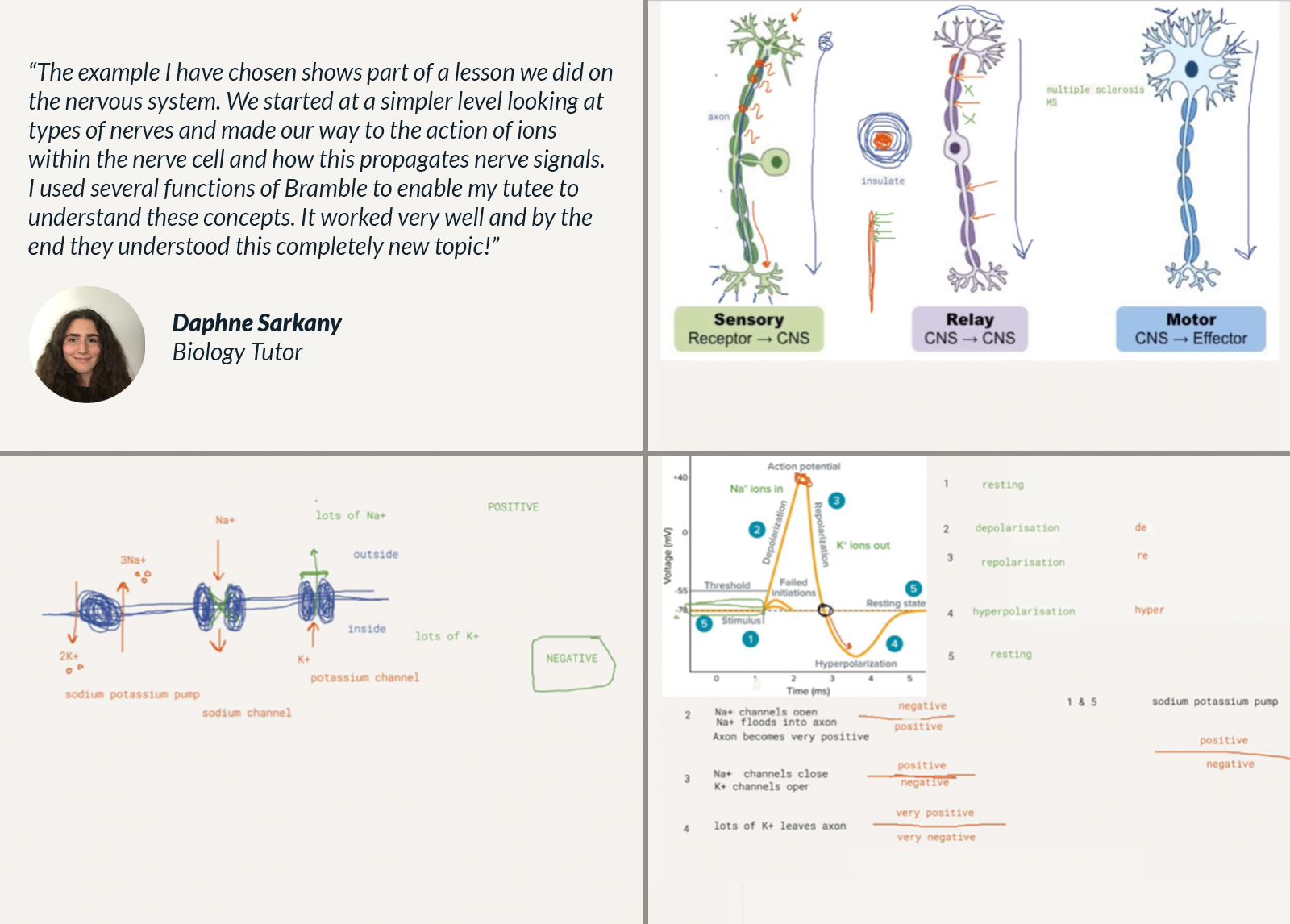
Example of an online biology lesson from tutor, Daphne Sarkany.
“Saving powerpoint slides as an image or PDF that you can upload directly into bramble to draw on has worked really well for me with diagrams and graphs etc. Prepping in Powerpoint is also really handy for exercises and worksheets.”
“If there is anything that you want students to print or view for next time, put it up at the end of the lesson so they can find it in the notebook. They can edit this and then upload it onto the first few pages of the next lesson's notebook. I have found this really helpful as the marked work and everything is in one easy place for the students where they can always find another copy.”
Maddie - Maths, Chemistry and Physics Tutor (400+ hours on Bramble)
“Be prepared by having a folder on your laptop for a student's session where you can drop all the resources you might need so they are easily accessible. Make sure as many of the resources as possible have the potential for the student to interact on the screen. This makes them feel much more part of the session.”
Laura Stopforth - Biology, Chemistry and Physics Tutor (100+ hours online)
“Keep images open in extra tabs that you can cut and paste into your lesson to illustrate particular points.”
Zara Josephs - Biology, Chemistry and Physics Tutor (100+ hours on Bramble)
“Have resources ready to share on your computer such as images or past paper questions. Keep the cameras off as it allows everyone to feel less self conscious. Check in with your tutee as it can be harder to tell how they are doing when you are not in person. And enjoy it!”
Daphne Sarkany - Science Tutor
“Plan with your student first and upload the materials before the session – it saves a lot of time!”
Kim Li-Lakkappa - Biology Tutor (100+ hours on Bramble)
“It is important to interact and use the whiteboard to write content along with slides. This allows the student to focus. According to an article by the Institute of Physics it has been found that using a whiteboard is more engaging than using presentation slides".
Alok Singh - Science Tutor
As a final point, you can preload any of your materials into your lesson before the session starts. So you don’t necessarily need to be uploading during the session if you prefer all of your lesson content in from the start. I prefer dragging and dropping resources during a session for additional flexibility, but everyone has their own preference.
4. Using different approaches
Research suggests that a combination of repetition and variation improves retention and conceptual understanding of subject matter. That’s why it’s so important to incorporate these factors into your online tuition.
Let’s look at how you might do this, starting with variation.
Variation
Most online science lessons will involve a combination of the following:
- Drawing and labelling diagrams
- Going through experiments and practicals
- Answering homework or exam questions
Depending on your student’s age, level and the time of year, you may need to take a different approach to your science tuition.
For example, I typically find that during the first part of the year, taught sessions will often focus on acquiring subject knowledge. This is best done through the use of diagrams, examples, metaphors and analogies. During the examination seasons, there is an obvious switch to application of knowledge through questions and exam papers.

Example of a typical physics lesson I'll have with a GCSE student preparing for an exam. We'll collaborate on questions using different colours.
“Bring a blend of different approaches to online tutoring - i.e. drawing diagrams and labelling; attaching past paper questions and having the student attempt it live (helps identify misconceptions); watch videos and take screenshots to attach to Bramble and discuss further.”
Rubeena - Chemistry Tutor (50+ hours on Bramble)
“Use the screen to write processes out step by step, use different colours to highlight different steps, paste in diagrams and write on them to explain a concept. Writing directly onto the screen is a lifesaver.”
Jasmine - Biology, Chemistry and Maths Tutor (150+ hours on Bramble)
“Personalise the content to the student. Work out how they best learn and then tailor the session to support them the most. Break up the content with either different activities, or just time to go off on a random tangent and talk about something different. It helps to build that relationship and mitigate the professional barrier a student might have with a teacher.”
Nkosi Yearwood - Biology, Chemistry and Maths Tutor (100+ hours on Bramble)
“It's important to ensure you use the tone and pitch of your voice to convey the interest you have for your subject. Likewise, it's important to not shy away from questions such as "do you understand" or "would you like me to explain this in a different way" if it seems like the student is struggling. They may state that they do understand (and this would be a good opportunity for you to ask if they could explain it back to you in their own words), or you could identify that they are struggling, and you can help improve their confidence by explaining it in a different way.”
Alec Morley - Science Tutor (100+ hours on Bramble)
“Using the right online whiteboard/platform makes a world of difference, find the one that you think gets the most out of your students, and which allows you to support their learning to the fullest!”
“When teaching online, you need to be much more vocal in what you are thinking and doing, and make sure you are visually communicating with your students too. That way you can help them to keep up with you, and can hopefully pick up on any clues from them to help them feel more confident in their learning!”
Alyssa Fox-Charles - Chemistry Tutor (150+ hours on Bramble)
“Make sure to plan your sessions with lots of frequent questions for tutees that really make them think!”
Francis Mitchell - Science Tutor (100+ hours on Bramble)
Along with variation, the other important factor we must consider is repetition.
Repetition
To incorporate repetition into my science tuition, I encourage my students to use Smart Search to revise from our lessons and learn from their learning.
Search Based Learning unlocks the true value of online tutoring by allowing students to learn from the sessions they’ve had with you at the click of a button. This makes revision and repetition of specific topics, subtopics and entire lessons much more efficient and less confusing than if the student were to use different textbooks or search engines, where they might find conflicting information; or worst still, irrelevant information.
Using Smart Search allows my students to use their own personalised tutoring lessons that they’ve had with me, safe in the knowledge that they are revising from information the way they learnt it and from a trusted source.
The example below shows Smart Search in action on my session library.
5. Tracking student progress
The sciences are very quantitative subjects so it makes sense to take a quantitative approach to student progress. There are a couple of different ways you can do this:
- Use assessment resources such as examination papers
- Use CUE ratings after each session
Using assessment resources is perhaps the most traditional approach to quantitative assessment.
Most of my students are studying towards their A-levels or GCSEs, so exam materials are a necessary component of effective tuition and assessment. I’ll often use exam questions by topic during the term and prior to mid-term tests and full exam papers in the leadup to an A-level, AS or GCSE exam.
In order to assess how my students answer exam questions, I’ll either import the whole exam paper into Bramble and ask them to do it directly online, or they will complete a physical copy and we will scan the questions and import them at a later stage.
CUE ratings are an important addition to assessing students' progress. Released in 2021, they enables tutors to feedback on student:
- Confidence
- Understanding
- Engagement
You can also add details about what assessments were completed during the lesson.
CUE Ratings are a useful complement to examination papers for a number of reasons:
- You can track student progress from lesson to lesson and quickly get feedback on topics the student might be struggling with.
- It can be used for students of all ages where examination resources might not be as readily available (for example, primary and lower secondary years).
Using a combination of approaches to assessment I’m able to quickly discover what science topics and subtopics my students need more help with and speed up their progress.
6. Insights from 1.5 million hours
The utility of an online tutoring platform should stretch beyond the lesson itself. As we discussed above, one aspect of this is feedback and allowing for congruence between sessions. The other is to derive meaningful insights from the sessions.
This section examines some of the insights we can derive from science lessons on Bramble at the time of writing. In total, this accounts for over 315,000 hours of online science tuition - about 20% of the 1.5 million hours delivered on Bramble.
The percentage breakdown is as follows:
- Chemistry - 9.0%
- Biology - 6.4%
- Physics - 5.5%
Interestingly, this broadly mirrors the popularity of these subjects chosen at A level in the UK.
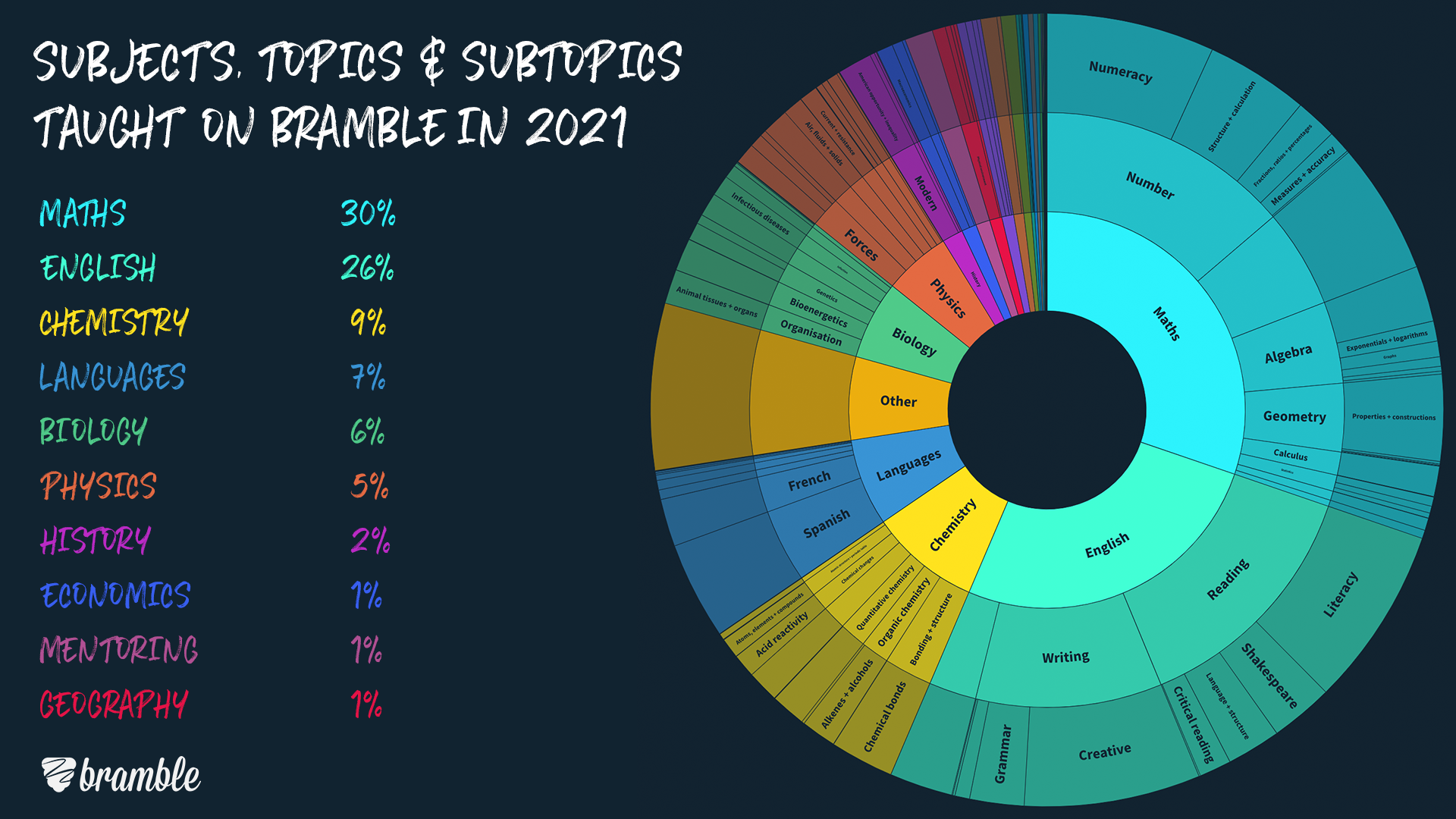
If we break each of these subjects down into their topics, the percentages are as follows:
Chemistry
- Bonding & structure (28% of all online chemistry lessons)
- Organic chemistry (17%)
- Quantitative chemistry (16%)
- Chemical changes (11%)
- Atomic structure & periodic table (9%)
- Chemical analysis (3%)
Bonding and structure, organic chemistry and quantitative chemistry comprise over 60% of the online chemistry lessons delivered on Bramble. This tallies with what I’ve seen as a chemistry tutor. Not only do these represent large parts of the specification at GCSE and A level, but they are also foundational topics which require a depth of understanding to do well in examinations.
Biology
- Organisation (22% of all online biology lessons)
- Bioenergetics (21%)
- Genetics (17%)
- Infection (13%)
- Ecology (9%)
- Cells (3%)
Organisation is the most popular topic covered on Bramble. It contains subtopics such as enzymes, the circulatory system and cardiovascular disease. Bioenergetics is also a popular topic covered during online biology tuition, comprising topics such as photosynthesis and respiration. Together these two topics account for over 40% of all biology lessons on Bramble.
Physics
- Forces (30% of all online physics lessons)
- Waves (15%)
- Electricity (14%)
- Energy (10%)
- Magnetism (8%)
- Space (2%)
Forces is by far the most popular topic covered in physics, comprising 30% of all physics lessons on Bramble. In part, this might be due to the size of the topic. In most specifications it is the largest topic, containing subtopics such as resultant forces, Newton's laws of motion, moments, momentum and other areas of mechanics.
Topics such as waves, electricity and energy appear to have a similar number of tutoring hours; whilst the smaller topics, such as magnetism and space are the least popular topics to receive online tutoring.
Personalised insights from my own session library
Using Smart Search, I can see how popular some of these topics are using keywords from my library of almost 1,000 hours of online science tutoring.
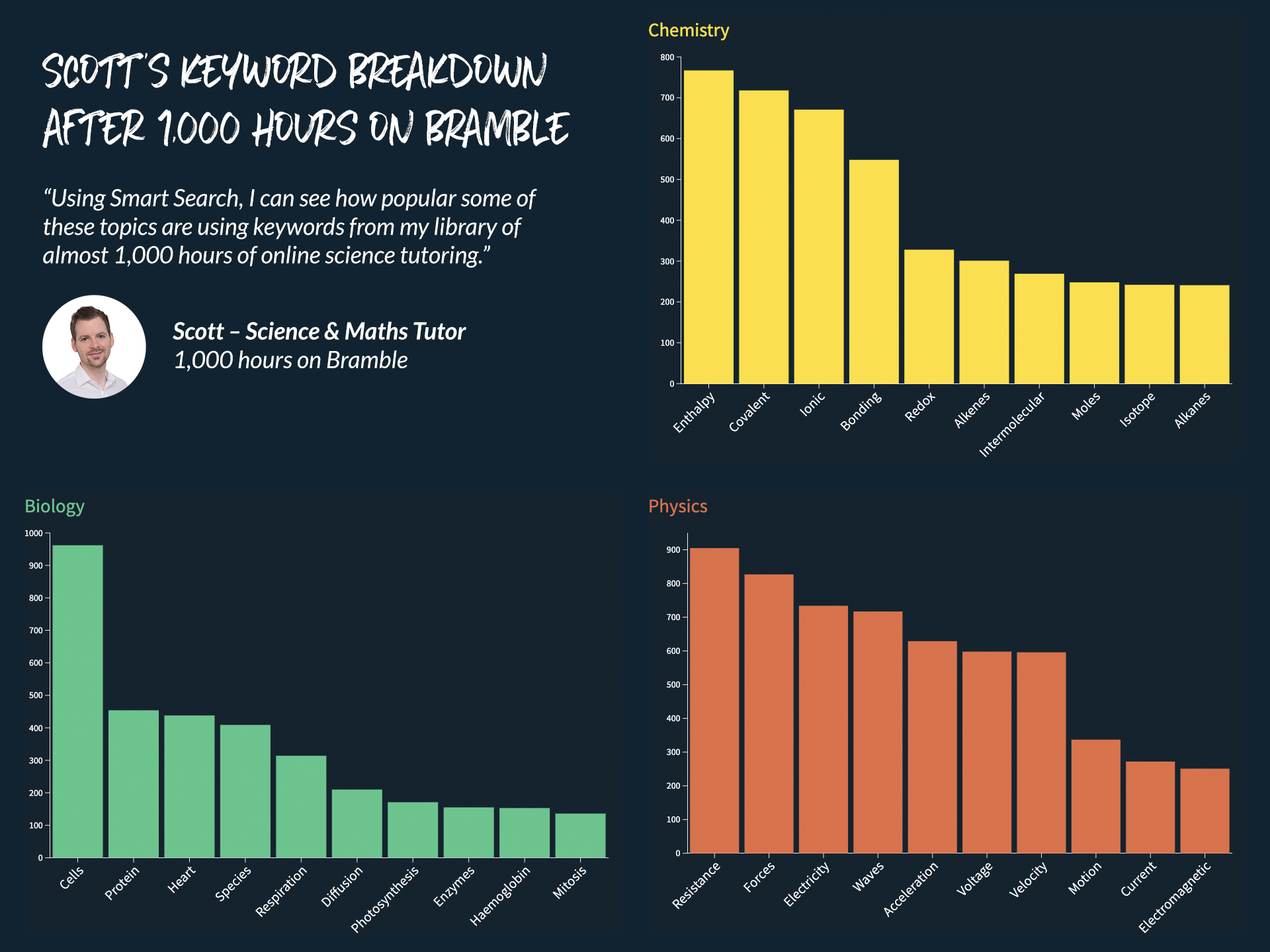
Popular topic and subtopic terms for my chemistry, biology and physics lessons. Data populated using Smart Search.
Lets start with chemistry.
Chemistry has higher count rates across more topics than physics or biology due to it being my most tutored subject. In the chart above I’ve included some of the most popular key terms and concepts with over 200 hits on Smart Search.
As you can see, many of these terms belong to the most popular topics tutored on Bramble, such as bonding and structure, organic chemistry and quantitative chemistry. Because my sessions contain a combination of GCSE and A level lessons, you would expect less volume from a term that is unique to the A level specification; such as entropy (180 hits), ester (71 hits) and Born-Haber cycle (33 hits).
Now lets look at biology.
Due to the fact that I tutor biology less frequently than chemistry, I’ve included terms and concepts with over 100 hits.
Again, we can see a lot of terms from the most popular topics listed above. For example, protein, enzymes, and the heart all belong to the topic, organisation. Photosynthesis and respiration are part of the topic bioenergetics. The key term cells is particularly high in my search results because I’ve had a lot of students at A level who study cells in more depth. As a term or keyword, it’s also less specific than some other terms.
Finally, lets compare physics.
Most of the terms at the top of this list are also topics, such as forces, electricity and waves; so it’s little wonder that they also have a high volume of session hits. Most of the other terms highlight subtopics within these three topics. For example, reflection (225 hits), refraction (211 hits), transverse (162 hits), longitudinal (116 hits) and diffraction (115 hits) are all part of the waves topic. Resistance, voltage and current are sections of the electricity topic.
Overall, these insights should give you a good idea of some popular science topics taught online. Using this type of information from your sessions should provide you with a good understanding of:
- Areas of high demand
- Topics and subtopics students need the most help with
- What areas to focus on when building a resource library
Special Thanks
Finally, we would like to offer our thanks to all of the science tutors who contributed to this article. We received some fantastic tips and examples of what contributes to delivering effective online science lessons.




